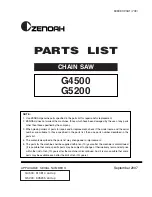
POW64122
EN
Copyright © 2013 VARO
P a g e
|
5
www.varo.com
Keep all parts of your body away from the saw chain when the engine is running.
Before you start the engine, make sure that the saw chain is not contacting anything.
Carry the chain saw with the engine stopped the guide bar and saw chain to the rear, and
the muffler away from your body.
DO NOT operate a chain saw that is damaged, improperly adjusted, or not completely and
securely assembled. Be sure that the saw chain stops moving when the throttle control
trigger is released.
Shut off the engine before setting the chain saw down.
Use extreme caution when cutting small size brush and saplings because slender material
may catch the saw chain and be whipped toward you or pull you off balance.
When cutting a limb that is under tension, be alert for spring back so that you will not be
struck when the tension in the wood fibers is released.
Keep the handles dry, clean, and free of oil or fuel mixture.
Operate the chain saw only in well-ventilated areas.
DO NOT operate a chain saw in a tree unless you have been specifically trained to do so.
All chain saw service, other than the items listed in the user manual safety and
maintenance instructions should be performed by competent chain saw service personnel.
When transporting your chain saw, use the appropriate guide bar scabbard.
DO NOT operate your chain saw near or around flammable liquids or gases whether in or
out of doors. An explosion and/or fire may result.
Do not fill fuel tank, oil tank or lubricate when the engine is running.
USE THE RIGHT TOOL: Cut wood only. Do not use the chain saw for purposes for which
it was not intended. For example, do not use the chain saw for cutting plastic, masonry, or
non-building materials.
The first time user should have practical instruction in the use of chainsaw and the
protective equipment from an experienced operator.
Do not attempt to hold the saw with one hand only. You cannot control reactive forces
and you may lose control of the saw, which can result in the skating or bouncing of the bar
and chain along the limb or log.
Never run the chainsaw indoors. Your chainsaw produces poisonous exhaust as soon as
the combustible engine is started, which may be colorless and odorless. To use this
product can generate dust, mists and fumes containing chemicals known to cause
reproductive harm. Be aware of harmful dust, mist (such as saw dust or oil mist from chain
lubrication) and protect your self properly.
Wear gloves and keep your hand warm. Prolonged use of chainsaws exposing the
operator to vibrations may produce white finger disease. In order to reduce the risk of
white finger disease, please wear gloves and keep your hand warm. If any of the white
finger symptoms appear, seek medical advice immediately.
Drive in the spiked bumper of the chainsaw directly behind the intended hinge and pivot
the saw around this point. The spiked bumper rolls against the trunk.
Only chain, guide bar and spark plug can be replaced by the user himself. Always make
sure you replace with correct material as stated in the specifications of the manual.
6
KICKBACK SAFETY PRECAUTIONS
KICKBACK may occur when the NOSE or TIP of the guide bar touches an object, or when
wood closes in and pinches the saw chain in the cut.
Tip contact in some cases may cause a lightning-fast reverse reaction, kicking the guide bar
up and back toward the operator.
PINCHING the saw chain along the BOTTOM of the guide bar may PULL the saw forward
away from the operator.






































